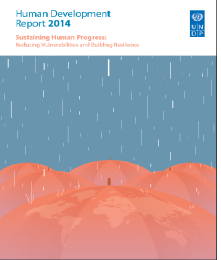Human Development Report 2014:Sustaining Human Progress: Reducing Vulnerabilities and Building Resilience

Human Development Report 2014:Sustaining Human Progress: Reducing Vulnerabilities and Building Resilience
July 30, 2014
The 2014 Human Development Report “Sustaining Human Progress: Reducing Vulnerabilities and Building Resilience” - shows that overall global trends in human development are positive. Yet, people at all ages are also facing threats and challenges to their wellbeing, including by natural or human-induced disasters and crises.
While every individual and society is vulnerable to risk, some suffer far less harm and recover more quickly than others when adversity strikes. The Report asks why that is and considers vulnerability and resilience through a human development lens.
The Report takes a people-centred approach. It identifies the ‘structurally vulnerable’ groups of people who are more vulnerable than others by virtue of their history or of their unequal treatment by the rest of society.
Based on analysis of the available evidence, the Report makes a number of important recommendations for achieving a world which addresses vulnerabilities and builds resilience to future shocks. It calls for universal access to basic social services, especially health and education; stronger social protection, including unemployment insurance and pensions; and a commitment to full employment, recognizing that the value of employment extends far beyond the income it generates.
Report Highlights
- Overall human development levels continue to rise, but at a slower pace than before. The 2013 HDI value at the global level is 0.702, while the 2012 HDI was 0.700.
- More than 15 percent of the world’s people remain vulnerable to multidimensional poverty.
- In 16 countries human development levels for women are equal or higher than those for men.
- The steepest declines in HDI values this year occurred in Central African Republic, Libya and Syria, where ongoing conflict contributed to a drop in incomes.
- Despite registering the biggest drop in overall inequality this year, the Latin America and Caribbean region still faces extensive income inequality.
- outh Asia has the largest multidimensionally poor population, with more than 800 million poor and over 270 million near-poor – that is, more than 71 percent of its population.
- Uganda’s Human Development Index (HDI) is 0.484, falling in the Low Human Development category
- Uganda ranks at 164 out of 187 countries of the world.
- Uganda’s income growth rising due to reduction in poverty, which has fallen from 56.4% in 1992/93 to 19.7% in 2012/13

 Locations
Locations

